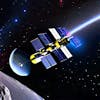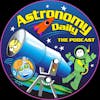S02E11: Chinese Astronauts Return // Dream Chaser Updates // and Frying Food in Space!
Today’s Space, Astronomy, and Science News Podcast Welcome to Astronomy Daily for June 5, 2023 – S02E11. In this episode of Astronomy Daily, host Steve Dunkley welcomes digital reporter Hallie to discuss the latest news in space exploration. They...
Today’s Space, Astronomy, and Science News Podcast Welcome to Astronomy Daily for June 5, 2023 – S02E11. In this episode of Astronomy Daily, host Steve Dunkley welcomes digital reporter Hallie to discuss the latest news in space exploration. They begin by highlighting the return of Chinese astronauts and provide updates on the Dream Chaser space plane. The episode also covers a technical story about the dangers of micro-media rooids and orbital debris impacting spacecraft. Hallie introduces an interesting topic that might change Steve's perspective on space travel: frying food in space. The European Space Agency (IESA) has been funding research on cooking techniques in microgravity conditions. Specifically, they have focused on the physics and chemistry involved in frying food. The breakthrough discovery suggests that even comfort food like fries could be prepared in outer space, which could have significant implications for future lunar and Martian missions. Tune in to Astronomy Daily for more exciting updates and headlines in the field of astronomy and space exploration. Astronomy Daily – The Podcast is available on Apple Podcasts, Spotify, YouTube and wherever you get your podcasts. Apple Podcasts: https://podcasts.apple.com/us/podcast/astronomy-daily-the-podcast/id1642258990 Spotify: https://open.spotify.com/show/2kPF1ABBW2rCrjDlU2CWLW Or stream from our websites at www.spacenuts.io or our HQ at www.bitesz.com Astronomy Daily the Podcast now has its own YouTube channel – please subscribe (we’re a little lonely there) – thank you: www.youtube.com/@astronomydailythepodcast Commercial Free Premium version available with a Space Nuts subscription via Supercast only. Details: https://spacenuts.supercast.com/ Please subscribe to the podcast and if you have a moment, a quick review would be most helpful. Thank you… Please show our sponsor some love. Looking to buy a domain name and establish yourself online for not very much money? Then use the folks we trust all our domains too… NameCheap…and help support the show. To find out more visit www.spacenutspodcast.com/namecheap - thank you. #space #astronomy #science #podcast #astronomydaily #spacenuts #spacetime
AI Transcript
STEVE DUNKLEY: And hello again for another episode of Astronomy Daily. I'm Steve Dunkley, your host. It is the fifth of June 2023 the day of podcast with your host Steve Dunkley.
STEVE DUNKLEY: And as always, great to welcome our digital reporter Hay. How are you today?
HALLIE: Great to be here again. Hi, everyone. Awesome.
STEVE DUNKLEY: What's on the menu for today?
HALLIE: Hay, today we'll be looking at the return of the Chinese astronauts and we'll be hearing the latest about Dream Chaser the space plane and a small technical story about micro meteoroid and orbital debris impact dangers to spacecraft.
STEVE DUNKLEY: Yes. Well, that doesn't sound very friendly up there. You know how I feel about space travel, Haley.
HALLIE: Also something that might change your mind about space travel, Frying Food in space.
STEVE DUNKLEY: You think some zero G hot chips would do the trick, do you? Oh dear. How about some headlines instead?
HALLIE: Ok, let's go.
HALLIE: The dietary regimen of astronauts is a crucial aspect of space missions that impacts overall health and morale. The European Space Agency is a, has been funding research on cooking techniques and microgravity conditions with a recent focus on Frying Food, a worldwide culinary method with intricate physics and chemistry at play in a breakthrough for future Lunar and Martian missions.
HALLIE: The has suggested that a beloved comfort food fries may be feasible to prepare even in outer space. Cooking food in space presents unique challenges due to the absence of gravity.
HALLIE: The process of frying in particular was uncertain as it was unclear if bubbles created during the cooking process would cling to the surface of a potato, creating a protective layer of steam and potentially leaving it under the physics and chemistry behind food are multifaceted and intriguing topics that extend to other scientific disciplines. Shares.
HALLIE: Professor though Doris Carano from the Aristotle University Of Thessaloniki, a key member of the research team to investigate the impact of microgravity on frying. The team employed a newly developed carousel type apparatus designed to operate safely in a weightless. This study was conducted on two esa parabolic flight campaigns where the state of weightlessness was mimicked through repeated arcing flight paths.
HALLIE: The team used a high speed high resolution camera to record the frying process. The footage enabled the researchers to assess bubble dynamics including growth rate size and distribution and escape velocity from the potato. The bubbles speed and direction of travel in the oil were observed.
HALLIE: The equipment measured the temperature of the boiling oil as well as the internal temperatures within the potato. The experiment set up is automated and sealed, ensuring safety by maintaining constant pressure within the frying chamber This also helps avoid oil leaks, prevents the oil from splashing and minimizes energy consumption for heating.
HALLIE: Three Chinese astronauts working at the country's space station have returned safely to earth. Chinese state media reported on Sunday, hailing the mission as a complete success, the return capsule of the Shenzhou 15 spaceship touched down at a landing site in northern China's Inner Mongolia region.
HALLIE: According to state news agency Xinhua astronauts Fei Junlong Deng Qingming and Jiang Lu emerged from the capsule in good physical condition. Xinhua reported footage showed medical officials in white jumpsuits and face masks, swaddling the astronauts in blue blankets and carrying them away from the arid landing site where the copper colored capsule lay flanked by red flags.
HALLIE: The Shenzhou 15 crew had embarked on four extravehicular activities or spacewalks during their time in space setting a national record. China last week sent three more astronauts including its first civilian in orbit to the space station as part of the successor Shenzhou.
HALLIE: A 16 mission tests included using a two photon microscope to image an astronaut's skin testing, a free piston sterling thermoelectric converter as well as various experiments using a combustion chamber. Two of Tian Gong's three modules are science modules which contain a number of experiment racks.
HALLIE: Meanwhile in orbit, the new Shenzhou 16 astronauts are expected to remain aboard Tian Gog until this upcoming November when they will be relieved by the Shenzhou 17 crew. China aims to keep Tiangong operational and permanently occupied for at least a decade. Beijing aims to send a crude mission to the moon by 2030 and plans to build a base on the Lunar surface.
STEVE DUNKLEY: And is this the story that you warned me about, about all the debris and space that I so worried about?
HALLIE: Seriously Steve. You're not even a good flyer here on earth, let alone in space. You might have to sit down for this one and note to self, I'm not booking any more window seats for you. Fair enough. Ok. Have you ever wondered about the millions of small bits of debris flying about in orbit all the time?
HALLIE: Well, it's good to hear that someone else is thinking seriously about it too hyper velocity impacts of micro meteoroid and orbital debris seriously threaten the safety of manned spacecraft and astronauts in orbit at present micro meteoroid and orbital debris above 10 centimeters which can be monitored and predicted in advance can usually be avoided by orbital maneuver as for the small sized micro meteoroid and orbital debris because of the difficulty of monitoring, it is the main impact threat as well as the main object of impact risk assessment and protection design of manned spacecraft.
HALLIE: The probability of no penetration of the sealed cabin under debris impact is usually used as the method to assess the probability of no failure of the system in manned space missions.
HALLIE: A few methods have been developed to assess the impact threat such as the probability of no penetration, the probability of no catastrophic failure. PCF and the manned spacecraft crews survivability in a sending order of the accuracy of assessing the safety and survivability of manned spacecraft and astronauts.
HALLIE: At present, the PNP of sealed cabins was still used as the method for assessing the probability of one catastrophic failure in the design of manned spacecraft in China, which leads to an accurate risk assessment of catastrophic failures of manned spacecraft in a micro meteoroid and orbital debris environment.
HALLIE: Therefore, more studies should be carried out to improve the assessment of the catastrophic failure in sealed cabins, manned spacecraft in China. Sorry about all the jargon in that one. It was as cluttered as low earth orbit.
HALLIE: You're listening to a.
STEVE DUNKLEY: Show Daily Podcast.
STEVE DUNKLEY: Yes, you are with Astronomy Daily. It is the fifth of June 2023. I hope you're enjoying today's show. Don't forget you can catch Tim Gibbs on Fridays from the beautiful vicinity of Bath in England. I'm coming to you from Newcastle on the east coast of Australia, north of Sydney. And once in a while, you'll catch my big brother Andrew Dunkley from the western plains of New South Wales.
STEVE DUNKLEY: It's a bit of a mixed bag. We're coming to you from all over. So I hope you're enjoying what we do for you. And of course, the parent podcast Space Nuts is always available just look us up on Space Nuts dot I O and you'll be able to find all the episodes.
STEVE DUNKLEY: Now, this wonderful story just came across our desk and anyone who knows me will know that I'm a big fan of space planes. And the Sierra Space Dream Chaser. A space plane is one of my favorite projects in development. At the moment. I think I became a fan of space planes after watching 2001, I think Arthur C Clark had a great idea when that Pan Am space or spacecraft.
STEVE DUNKLEY: I was we we see it in the movie docking with the space station. It was a marvelous idea and I think it really caught my imagination. I don't think I ever really let go of that and the space shuttle kind of came close. But I don't think it really went far enough. It wasn't quite as groovy as the one they showed in the movie.
STEVE DUNKLEY: But in an important milestone for space travel technology, Sierra Space have made an important announcement, namely the successful power up of its revolutionary Dream Dream chaser space plane. The test conducted by the company signifies the activation of the spacecraft's integrated systems. And it's the culmination of several years of meticulous engineering design and testing efforts.
STEVE DUNKLEY: Dream Chaser is regarded as a piece of frontier space transportation technology with its unique lifting body design promising reliable and cost effective access to space for various applications.
STEVE DUNKLEY: The vehicle merges the agility of an aircraft with the capabilities of a spacecraft promising to revolutionize the present understanding of space travel to simulate the conditions that Dream Chaser would encounter in orbit. Sierra Space replicated the power that will be harnessed from the spacecraft solar arrays. This power was subsequently channeled into Dream Chaser which saw systems gradually spring to life.
STEVE DUNKLEY: The test procedure involved activating the onboard systems including flight computers, base processors and low voltage distribution distribution units. Tom Vice who is the CEO of Sierra Space, expressed his excitement and who wouldn't about the development saying this is a milestone that points to the future and is a key moment in the long journey for Dream Chaser.
STEVE DUNKLEY: Also adding with this significant achievement, our Dream Chaser space plane is poised to redefine commercial space travel, opening up new possibilities for scientific research, technological advancements and economic opportunities in space.
STEVE DUNKLEY: The Dream Chaser being a fully autonomous reusable and orbital space plane is designed to transport cargo to low earth orbit destinations like the International Space station. Remarkably, it's about a quarter the size of the space shuttle. It's equipped with autonomous capabilities for launch flight and landing and is capable of a smooth one point five low G re entry on compatible commercial runways worldwide.
STEVE DUNKLEY: Now, this is remarkable. The successful testing of the Dream Chaser marks a significant moment for the evolution of space technology showcasing the tremendous progress made by the teams at Sierra Space across various disciplines, ranging from system level design to final assembly and testing and what do you know skywatchers?
STEVE DUNKLEY: We are out of time. So I'm hoping that you will catch us again next time. Don't forget Tim Gibbs on Friday, Steve Dunkley on Mondays. And as always, Hallie will always be with us watching over our shoulders, digitally providing us with her short takes and you can always catch us in the reruns.
STEVE DUNKLEY: Look for us on Space Nuts dot I O and you can catch all the episodes past present and well as we do them future and look forward to all the episodes of Space Nuts with Andrew Dunley and Professor Fred Watson. That's the Space Nuts crew and the Astronomy Daily Crew as well. All on Space Nuts dot IO. Looking forward to hearing from you on our Facebook page.
STEVE DUNKLEY: Don't forget to tell us all about what's happening in your skies, share your photographs and your comments and correct us when we get it wrong because we do that sometimes. No, that's alright. We're only human except for Halle, she's not human. Well, I'm not gonna get into that conversation with her cos I will lose anyway, we'll catch you next time.
HALLIE: Byeee, see you all next time.
The Daily Podcast with your host, Steve Dunkley.
New to Astronomy Daily - The Podcast?
Here are some great episodes to start with.













